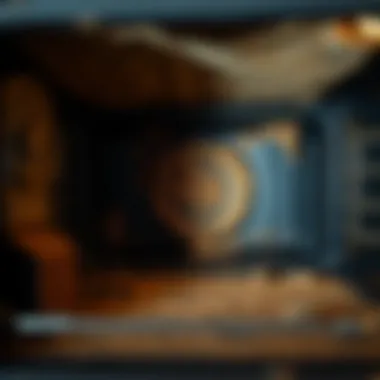Effective Strategies for Cleaning a Dirty Oven


Intro
Cleaning an oven may not be the most glamorous chore on the household list, but it’s sure critical for maintaining a clean kitchen. A dirty oven can lead to unpleasant odors, uneven cooking, and even grease fires. Understanding effective strategies for tackling this task can save both time and frustration. This article walks you through various approaches to oven cleaning, from traditional methods to modern solutions. If you're a homeowner or a passionate cook, you’ll want to make your cleaning routine as efficient and thorough as possible.
Design Inspiration
Keeping the kitchen aesthetically pleasing can complement a clean oven. A bright, appealing environment encourages cooking and gathering with family and friends. In essence, an effective oven cleaning strategy ties back to overall kitchen maintenance.
Trending Styles
Modern kitchens often feature open layouts with sleek appliances. Stainless steel has become a crowd favorite, known for its durability and ease of cleaning. Pairing your oven with complementary materials, such as granite or quartz countertops, adds sophistication.
Interestingly, many people have started adopting minimalist styles. A less cluttered workspace not only looks nicer but also simplifies cleaning tasks. A minimalistic oven design can be easier to maintain, creating a pleasant cooking environment.
Color Palettes
For colors, neutral tones seem to dominate kitchens due to their timeless appeal. Warm whites and soft greys create an inviting space. When you incorporate brighter hues through accessories, it can rejuvenate the kitchen atmosphere without overshadowing your oven.
Remember, a well-kept kitchen can uplift the mood, making it imperative to pair effective cleaning techniques with inspiring designs.
Practical Tips
Maintenance & Care
A dirty oven doesn’t stand a chance against consistent maintenance. Here are some significant pointers to help keep your oven spotless:
- Wipe Down After Use: After each use, it’s useful to wipe surfaces with a damp cloth, allowing grease and food particles to loosen before they harden.
- Spot Clean Regularly: Small spills can quickly magnify if left unchecked. Clean them up right away to prevent larger issues down the line.
- Deep Cleaning Schedule: Establish a regular deep cleaning routine, perhaps considering monthly or quarterly intervals depending on usage.
Combining these tips can create a sustainable cleaning habit, making oven maintenance less daunting.
Budgeting & Planning
Planning the financial aspect of oven cleaning can come in handy. Here are a few essentials to consider when budgeting:
- Cleaning Products: Research quality cleaners that won’t break the bank. Look out for alternatives like vinegar and baking soda for cost-effective solutions.
- Tools: Invest in reusable scrubbers, brushes, and microfiber cloths for a more effective cleaning experience.
- Time versus Money: Sometimes, hiring professional services can be worthwhile if cleaning seems overwhelming. Weigh the pros and cons before making a decision.
Adapting these practical tactics not only streamlines the process but ensures you reap the benefits long-term.
"An organized kitchen leads to an organized mind!"
A clean oven is just the cherry on top when it comes to kitchen maintenance.
Understanding Oven Cleaning
Cleaning an oven might seem like a chore many would rather avoid, yet grasping the significance of this task goes beyond just aesthetics. A well-maintained oven is essential not only for functionality but also for health and safety in your kitchen. It's not merely about avoiding burnt-on food; it’s about ensuring that your culinary environment remains germ-free and pleasant.
The Importance of Regular Cleaning
Regular cleaning of your oven should not be underestimated. Over time, grease, food particles, and smoke can accumulate, creating not just unsightly stains but also potential fire hazards. When these residues are heated during cooking, they can emit unpleasant odors and even harmful fumes. It’s akin to letting a covered pot boil over without the lid; trust me, it’s bound to get messy and spoil the boil.
Moreover, a clean oven functions better. When there’s excess grime, it can impact heating efficiency, leading to uneven cooking or longer preheating times. By keeping the oven clean, you’ll find that meals come out just right, time and again.
In the grand scheme of kitchen care, think of regular oven maintenance as a preventive measure. You wouldn’t drive a car without regular oil changes or tire rotations, just like you shouldn’t use an oven that hasn’t been cared for in a while. A little effort can save big headaches later.
Common Types of Oven Dirt and Grime
When it comes to oven cleaning, understanding the types of dirt and grime involved makes the task a lot easier. Here are some of the common offenders you’ll likely encounter:
- Grease: This is possibly the biggest culprit. Spatters from cooking meats or baked goods often get stuck to the sides, dripping down and creating unsightly build-up.
- Baked-on Food Residue: When food spills, it can harden and become difficult to remove. This residue often turns into a pervasive black crust that seems impossible to scrub away.
- Carbon Deposits: High-temperature cooking can lead to carbon buildup, especially if food gets burnt or charred. These black marks are both unsightly and can impact food flavor if not dealt with.
- Burnt Smells: While technically not dirt, a dirty oven may generate unwanted odors, which can linger and affect the taste of your dishes.
By understanding these different types of dirt, you can tailor your cleaning strategy to effectively tackle each one, allowing for a more effective and focused cleaning session. Not every sprinkle of grime calls for the same approach, so it’s better to know your enemies well.
"A clean oven is a happy oven. A happy oven produces happy meals."
Taking the time to understand and manage your oven’s cleanliness pays off in both taste and appliance longevity. The next steps about assessing your oven type and what tools to use will further enhance your oven care regimen.
Assessing Your Oven Type
Determining the type of oven you have is pivotal when considering effective cleaning strategies. Each kind of oven—gas or electric—comes with its idiosyncrasies that can influence the cleaning process, impacting both the effectiveness of the cleaning effort and the safety of the procedure. It's like knowing the lay of the land before embarking on a journey; if you don’t understand your starting point, you might wander off course.
Gas vs. Electric Ovens
Gas ovens, often heralded for their quick heating capabilities, have unique characteristics requiring specific care. One notable aspect of gas ovens is their use of a pilot light, which can accumulate grease and grime over time. Properly identifying these buildup areas can greatly enhance the efficacy of your cleaning efforts. To clean a gas oven:
- Turn off the gas supply to avoid any hazardous situations.
- Use a non-abrasive cleaner, as harsh chemicals can damage the surfaces.
- When tackling the burners, remember to removal any debris lodged around them.
On the flip side, electric ovens are generally easier to maintain because their designs minimize food splatter. However, the heating elements can become coated with grease, making periodic cleaning essential to maintain efficiency. For electric ovens:
- Cool down completely before beginning any cleaning regimen.
- Employ baking soda and water for a natural cleaning solution, providing a safe and effective way to deal with tough stains.
When it comes to cleaning, both types of ovens require a tailored approach. Homeowners must assess their appliances not just for their heating source but also for how this might relate to cleaning protocol.
Self-Cleaning Ovens
Self-cleaning ovens present a bit of a paradox. They save labor time by using high temperatures to incinerate residue, leaving only a fine ash to wipe away. However, it's important to note that this process can produce fumes that some might find unpleasant or even harmful. Furthermore, not all ovens are created equal; some self-cleaning models have specific requirements that need to be understood.
Here are a few tips to keep in mind:


- Read the manual carefully: Each model may have particular instructions for self-cleaning that should be adhered to for optimal safety and performance.
- Ventilate the area: Opening windows or using an exhaust fan can help dissipate any odors produced during self-cleaning.
- Plan your timing wisely: The self-cleaning cycle can take several hours, so it's best to initiate it when you won’t need the oven for meal prep.
In the grand scheme of oven maintenance, understanding the type of oven you have is like having a map before heading into the great unknown. The right insights will enable you to make informed decisions about your cleaning methods, ensuring a cleaner, safer kitchen environment.
Essential Cleaning Supplies
When it comes to cleaning your oven, having the right supplies in your arsenal can make a monumental difference. Think about it: the success of your cleaning endeavor hinges on the tools and materials you choose to utilize. Selecting the appropriate cleaning supplies not only streamlines the process but also enhances the effectiveness of the results you achieve. Thus, understanding what you need and why it’s integral is paramount before diving into the actual cleaning.
Natural Cleaners
Using natural cleaners helps homeowners feel good about their cleaning choices. These options typically boast fewer harsh chemicals, allowing one to tackle grime without fuming up your kitchen. Plus, they often come right from the pantry.
Baking Soda
Baking soda shines in the world of cleaning agents. Its primary aspect? The ability to lift stubborn stains and neutralize odors. This humble powder is not just a baking companion. It’s a true workhorse in cleaning routines. Among its key characteristics, its mild abrasiveness allows it to scrub away stuck-on food without scratching surfaces. For that reason, many folks rely on baking soda for their oven cleaning tasks.
A unique feature of baking soda is its effervescent reaction with vinegar, creating tiny bubbles that help dislodge dirt. While it's a very effective natural cleaner, sometimes it takes a little elbow grease for tougher spots. Overall, it’s a popular choice because it’s safe, affordable, and remarkably versatile, making it an indispensable element in any oven-cleaning strategy.
Vinegar
Vinegar can be your best friend in the battle against grime. Its high acidity cuts through grease and odors, making it a fantastic ally in the kitchen. This standout feature is what sets vinegar apart as a beneficial option for oven cleaning.
Vinegar’s unique attribute is its ability to dissolve mineral deposits, which can accumulate over time. A down side, however, is that its smell can be quite strong for some. But fear not; once the cleaning is done, the scent dissipates quickly. The combination of vinegar and baking soda creates a powerful duo, combining both cleansing and deodorizing properties, making it a go-to option for many homeowners.
Lemon Juice
The fresh scent of lemon juice offers not just a pleasant aroma but also remarkable cleaning capabilities. High in citric acid, lemon juice acts as a natural disinfectant. This is its predominant attribute that contributes to cleaning efficiency, particularly against grease and yellow stains.
One unique feature of lemon juice is its ability to work synergistically with baking soda, enhancing the cleaning power of both. However, lemon juice may not be as effective on heavily soiled surfaces when compared to harsher chemical cleaners. Still, its natural properties make it a fresh alternative that keeps things clean while smelling great.
Commercial Oven Cleaners
For those looking for a quicker route to a spotless oven, commercial cleaners might just be the ticket. These solutions are specially formulated to tackle even the toughest grime and stains with minimum fuss. However, when diving down this road, it is essential to be mindful of safety instructions and the specific needs of your oven type.
Aerosol Cleaners
Aerosol cleaners are among the go-to choices for quick fixes. They come in handy for those last-minute clean-ups before hosting guests. One of their primary characteristics is their ease of application; just spray and wipe away. Their convenience makes them a popular option for busy households.
The unique aspect here is how evenly they spread and cover surfaces, ensuring an even coating. Nonetheless, they can sometimes leave behind a sticky residue and generally require a thorough rinse afterward. Despite these minor drawbacks, many homeowners appreciate the time-saving aspect.
Gel Formulations
Gel formulations present a thicker alternative when cleaning up tough grime. Their consistency allows them to adhere to surfaces better, avoiding the common problem of running off before getting the chance to work. This means they can sit on stubborn stains longer, enhancing their cleaning abilities, especially on vertical surfaces.
While gels can effectively hover over dirt, they often take longer to dissolve messes compared to liquid solutions. Additionally, the selection is limited, and making sure they are compatible with your specific oven type before using them is essential.
Foaming Cleaners
Foaming cleaners create a rich lather that clings to dirty surfaces, providing long-lasting cleaning action. Their immediate advantage is that the foam can easily penetrate grease and grime, allowing for deeper cleaning.
What sets them apart is their dual-action cleaning and deodorizing properties. Moreover, foaming cleaners typically rinse off effortlessly. However, they can be pricey in comparison to other cleaning options and may not be as readily available in all stores. So, evaluating your cleaning priorities can help decide if they are worth the investment for your specific needs.
Step-by-Step Cleaning Process
The process of cleaning an oven can often feel like climbing a mountain. However, breaking it down into manageable steps not only makes the task easier, but also helps ensure thoroughness. A methodical approach allows homeowners to tackle each area effectively. This section aims to equip you with a clear plan of action, maximizing the results of your efforts while minimizing the risk of missed spots or poor cleaning results. Knowing the specific steps to take can save time and reduce frustration.
Preparing Your Oven for Cleaning
Before diving headfirst into the cleaning adventure, preparation is key. Taking time to ready your oven lays a solid groundwork for everything that follows, turning what can be a daunting chore into a more organized activity.
Removing Racks and Accessories
Removing racks and accessories is the first step of organizing your cleaning mission. This simple act clears the workspace, allowing you to access every nook and cranny without hindrance. It helps prevent scratches or damage to these items while cleaning the oven’s interior. The standout feature of this step is its role in safety—with no extraneous parts around, the risk of slipping or accidents diminishes. Plus, cleaning the racks separately means you can give them the attention they deserve without affecting the oven itself.
However, do consider that removing them means you need to find a good place to store them temporarily, so they don’t cause clutter. Being methodical in this step not only prevents chaos but ensures everything is back in its rightful place once cleaning is done.
Protective Measures
Safety is paramount when engaging with cleaning agents, especially in an enclosed space like your oven. Prioritizing protective measures like wearing gloves and using masks is essential to safeguard against fumes and irritation. This is a vital choice as it creates a buffer against any harsh chemicals that might interact poorly with sensitive skin or lungs.
A unique aspect of adopting protective measures is the added peace of mind during the cleaning process. Knowing you’re taking precautions allows you to focus more on getting the job done than worrying about potential hazards. While it may feel cumbersome at times, it’s a beneficial habit that promotes a safer and more effective cleaning environment.
Applying Natural Cleaning Solutions
Natural cleaning solutions come as a breath of fresh air, offering a less chemically harsh approach to oven cleaning. Not only do they cut through grime with efficacy, but they also present fewer health risks compared to their commercial counterparts. The beauty of using natural ingredients lies in their accessibility and effectiveness against standard oven messes.
Creating a Baking Soda Paste
Creating a baking soda paste serves as a remarkable strategy in your cleaning arsenal. The process is as simple as mixing water with baking soda to achieve a spreadable consistency. This paste shines in its ability to absorb odors and stains, clinging to grime for easy removal. One of the main characteristics of this method is its non-toxic nature, making it an ideal choice for families concerned with chemicals.
However, some may find issues with its slower action time—a common drawback. It might require patience as it needs time to work its magic, potentially leading to a longer cleaning window. Still, many find this extra time worth the natural peace of mind it provides.
Applying Vinegar for Enhanced Effect
Vinegar’s acidic nature makes it a stalwart cleaner, ideal for tackling those stubborn spots. When combined with the baking soda paste, it creates a powerful reaction that can lift grime effectively. The standout quality of vinegar lies in its ability to disinfect while removing hard water stains that might have settled in.
This combination reinforces the effectiveness of your cleaning efforts, ensuring that both odor and gunk don’t stick around long after your clean-up is done. On the flip side, its strong scent can be off-putting for some during the application process. A small price to pay when considering the efficacy it brings to the table.


Using Commercial Cleaners Effectively
For those who prefer a more direct approach, commercial oven cleaners are an option. They provide impressive results, but understanding how to use them effectively can make all the difference.
Applying the Cleaner
Applying a commercial cleaner requires attention to detail. Following the manufacturer’s instructions ensures optimal results while minimizing mishaps. The main advantage here is speed; these cleaners often require less time to work compared to natural alternatives. This can be a game-changer for busy homeowners looking to maximize results within a finite window.
Yet, caution is essential. Over-application can lead to harmful residues or reactions with the oven's interior. It’s advisable to take a measured approach, as some products may have specific requirements depending on the type of oven you have.
Timing and Safety Precautions
The timing of applying cleaners speaks volumes about effectiveness. Understanding how long to let the product rest before wiping down can make or break the outcome. It’s crucial to adhere to timing guidelines, granting sufficient time for the solution to break down the particles on contact. Coupled with safety precautions—like ensuring good ventilation—workers can keep themselves safe while achieving those sparkling results.
Failing to consider timing could lead to subpar results or potential hazards by combining products improperly. An attentive approach helps ensure you get the best from these commercial solutions.
Scrubbing and Wiping Down
Now that the hard work of application is done, it’s time to scrub and wipe the oven down thoroughly. This step is crucial for clearing away any remaining dirt or remnants of what you've applied, leaving a finish customers expect.
Selecting the Right Tools
Selecting the right tools is paramount during this phase. A good scrub brush or sponge tailored to your oven type can make the entire process easier. A standout characteristic here is efficiency; using the correct tools means less effort for a more thorough clean. Going for tools meant specifically for scrubbing reduces the risk of damaging surfaces as well.
However, the selection can be a bit overwhelming with so many products available on the market. It pays to do a little research to ensure you're picking the tool that works best for your specific oven material.
Techniques for Maximum Efficacy
Employing effective scrubbing techniques can turn a simple task into a fruitful outcome. Short, firm strokes are often more effective than long sweeping motions. Consistently targeting the greasy areas with undivided attention can ensure that every spot gets the right focus it needs. A unique feature of employing these techniques is that it allows for better distribution of effort, leading to brighter, cleaner surfaces.
However, some may find they need to put in a bit more elbow grease than anticipated, particularly if dealing with a baked-on mess. Balancing efforts between persistence and patience leads to superior results, reinforcing the adage that good things take time.
Final Touches and Maintenance Tips
As you wind down your cleaning adventure, final touches can elevate effort to greater heights. These finishing details ensure you see the fruits of all that hard work.
Wiping the Surfaces
Wiping down surfaces provides a polished, professional look. Using a clean, damp cloth removes any residual cleaning solution and dirt left behind. This step solidifies the overall effort, creating a truly clean oven that not only looks great but also operates efficiently.
The unique attribute of this step is its ability to bring together everything done thus far. It rounds off your hard work, ensuring nothing feels half-baked or incomplete.
Neglecting this could result in sticky surfaces that feel unclean, diminishing the satisfaction of your efforts and creating unwanted hazards.
Incorporating Regular Cleanings
Incorporating regular cleanings into your routine transforms your approach to oven maintenance. When cleaning becomes a habit, rather than a chore, it reduces buildup over time. This preventive approach means you're less likely to face overwhelming messes in the future, ultimately saving time and effort.
A unique feature of establishing a regular schedule is that it provides ongoing control over your oven’s condition. This can lead to better food preparation and improved efficiency.
It may seem like an easier said than done proposition for some, especially with busy lifestyles; however, establishing a reasonable cleaning schedule can yield remarkable benefits in the long run.
Safety Considerations
Cleaning an oven can be a tedious job, but safety must always come first. Not taking proper precautions can lead to accidents or even health hazards. This section illuminates several essential safety aspects, helping homeowners create a safe and efficient cleaning environment.
Personal Protective Equipment
When gearing up for oven cleaning, it’s crucial to don some personal protective equipment (PPE). Think of it as gearing up for a worksite, rather than just a chore.
- Gloves: A pair of sturdy, heat-resistant gloves controls exposure to harsh chemicals, especially if using commercial cleaners. You wouldn’t want those strong solvents to have a chat with your skin!
- Goggles: Protect your eyes. Sometimes, sprays or splashes can happen, and goggles can save you from unplanned discomfort. Remember, your eyes are priceless.
- Mask: If the cleaning products emit strong fumes, a mask can help filter out potentially harmful particles or odors. Think of it as giving your lungs a little vacation while you scrub away the grime.
It’s like a safety net; with these simple items, you can significantly reduce the risk of injuries and create a safer cleaning atmosphere.
Ventilation and Fume Extraction
Every time you open your oven to clean, you might release a cloud of unwanted odors or even harmful fumes into the air. This is where proper ventilation comes into play.
- Open Windows: Make sure your cleaning area is well-ventilated. If you have the chance, throw open those windows to keep the fresh air flowing.
- Exhaust Fans: Turn on any overhead kitchen fans or exhaust systems. These help to draw out any strong odors when using commercial cleaners, ensuring they're out of your space, while you clean.
- Air Purifier: If you really want to play it safe, having an air purifier can be a blessing. It can help to reduce airborne particles, ensuring that you’re breathing cleaner air while tackling your oven.
Proper ventilation isn’t just wise; it’s essential. It helps minimize the risks associated with harmful fumes and ensures a healthier environment.
Navigating the cleanup of a dirty oven can quickly become hazardous without these measures. By prioritizing safety considerations, you’re not only protecting yourself but also creating a more pleasant and efficient cleaning experience.
Troubleshooting Common Issues
Cleaning your oven can often feel like a Herculean task, especially with the stubborn stains and lingering odors that sometimes don't budge no matter how hard you scrub. This section aims to guide homeowners through two common issues that pop up: stubborn stains and residual odors. Addressing these issues not only makes your oven cleaner but also helps in maintaining a healthy cooking environment. Let’s dig into how to tackle these problems effectively.
Stubborn Stains
When it comes to stubborn stains, every cook has faced those pesky spots that seem to cling on like wet socks after a rainstorm. These stains can diminish the oven's appearance and, if left unattended, could even affect its performance. One effective method to approach this issue is by deploying additional cleansing techniques.
Additional Cleansing Techniques
One standout feature of additional cleansing techniques is their versatility. In addition to baking soda and vinegar, which are often the go-to options, there are a variety of other ingredients that homeowners might have lying around. For instance, a mixture of salt and lemon juice can be particularly effective against baked-on grime.
Advantages of these methods include:


- Cost-effectiveness: Most of these ingredients are already in your kitchen, making them budget-friendly.
- Non-toxic compositions: If you’re mindful about the chemicals you expose your family to, these natural remedies are a better choice.
On the flip side, disadvantages might include:
- Time-consuming: They often require a bit more elbow grease and longer application times compared to commercial cleaners.
By incorporating these techniques, you can save both your wallet and your health while tackling tough stains.
Assessing Damage
After trying to scrub those stubborn stains away, it's vital to assess any damage that might have occurred on your oven's surfaces or components. This step ensures that you don't inadvertently make matters worse during the cleaning process.
Why assess damage? Well, the key characteristic of this practice is that it helps save you from becoming trapped in a situation where you could aggravate scratches or chips that are already present. Damage assessment before applying cleansers ensures that you're opting for the right approach for your specific situation.
The unique feature here is that by understanding the material makeup of your oven's interior, you can choose a cleaning method that aligns with it.
Advantages:
- Preventive care: Spotting any concerns early could prevent costly repairs down the line.
- Targeted action: Tailoring your cleaning strategy based on damage means you're less likely to cause additional harm.
However, it might require a bit of extra scrutiny that can feel tedious, especially when you're eager for a clean oven.
Residual Odors
There's nothing worse than opening your oven door only to be greeted by a stale or burnt odor lingering from past meals. Left unchecked, these odors can permeate your kitchen and even the food being prepared. Tackling residual odors is crucial for maintaining the kitchen's atmosphere.
Identifying the Source
An important first step in addressing residual odors is identifying the source. Often, the smell can stem from spills or burnt debris stuck somewhere within the oven, which makes its presence known every time it’s heated up.
Identifying the source is beneficial because it pushes you towards an effective remedy. Each oven can have different nooks and crannies where odors might seep from, so determining the exact spot focuses your efforts.
Unique characteristics include:
- Increased efficiency: By knowing where to look, you save time and cleaning supplies.
- Long-lasting results: Directly targeting the odor source can ensure a fresher oven for longer periods.
On the downside, it may take a keen sense of smell and a bit of exploration to pinpoint the issue, which may feel aggravating.
Neutralizing Techniques
Once you've identified the root of the odor, the next logical step is deploying neutralizing techniques, which help eliminate offensive smells effectively. This could range from baking soda being placed inside the oven overnight to using activated charcoal for a more industrial approach.
Neutralizing techniques shine due to their quick results; you can often notice improvements in just hours rather than days.
Advantages include:
- Rapid effectiveness: Quick results make these methods more convenient for busy homeowners.
- Odor elimination: Many methods effectively neutralize rather than mask the smells.
Still, some methods may require continuous usage over time to maintain freshness, which can feel tiresome in the long run.
In summary, maintaining a clean oven isn’t just about scrubbing away dirt; it includes troubleshooting common yet frustrating issues like stubborn stains and residual odors. By mastering these aspects of your oven care routine, you ensure an efficient cooking environment that’s pleasant and healthy.
Long-Term Oven Care
Maintaining a clean oven extends beyond the occasional scrub-down. When you prioritize long-term oven care, you're not just ensuring that your cooking appliance looks good; you are also enhancing its efficiency and prolonging its lifespan. A well-maintained oven can save you time, energy, and potentially hefty repair bills down the road. Homeowners often overlook this, focusing instead on immediate cleaning needs rather than fostering a sustainable care strategy.
Establishing a routine cleaning schedule plays a crucial role in long-term care. This isn't merely about wiping the oven down after each use; it involves adopting proactive habits that prevent the buildup of grime and grease. Think of this as an investment. Just like you wouldn't let your car go without regular maintenance, your oven deserves the same level of commitment. It can significantly reduce that nasty surprise when you open your oven door to bake a cake and find a layer of baked-on splatter staring back at you, right?
"A clean oven is not only a happier oven but also results in better-baked goods."
Establishing a Cleaning Schedule
One way to keep your oven in tip-top shape is to create a realistic cleaning schedule. This doesn't have to feel overwhelming. Start by determining how often you use your oven. For those who tend to cook daily, a simple weekly wipe-down might suffice, whereas those who use their oven less frequently may only need a more thorough clean once a month.
Here's a basic outline for a cleaning schedule:
- Weekly Tasks:
- Monthly Tasks:
- Quick wipe down of the inner and outer surfaces.
- Clean the racks in hot, soapy water.
- Deep clean using natural or commercial cleaners.
- Check and clean any filth in the oven fan or vents.
Developing this habit helps keep the oven more manageable when you do clean it, and it creates a less daunting task. Plus, when you keep ahead of the buildup, it can even improve the cooking times and temperatures, as a clean oven operates more efficiently.
Choosing the Right Tools for Future Use
Now that you have a cleaning schedule set, it’s essential to equip yourself with the right cleaning tools. The availability of numerous products on the market can be overwhelming. However, a few effective and key items can make a significant difference without breaking the bank.
When selecting tools, consider:
- Non-abrasive sponges and cloths:
- Spray bottle for vinegar and water:
- Baking soda:
- Commercial oven cleaners:
- These prevent any scratches or damage to the interior surfaces of the oven.
- A handy solution for quick cleanings. Plus, it's eco-friendly.
- Effective for stubborn stains and non-toxic for regular use. Just mix with water to create a paste.
- If you opt for these, make sure to select ones that are safe for your particular oven type and always follow usage instructions carefully.
Having these tools on hand not only makes cleaning easier but also encourages you to stick with your schedule. Think of it like arming yourself before heading into battle, except this time, you're fighting grime instead of dragons.
Remember, consistency is the name of the game. By investing time in long-term oven care, you're setting yourself up for a hassle-free baking and cooking experience, keeping your kitchen in its best shape.















